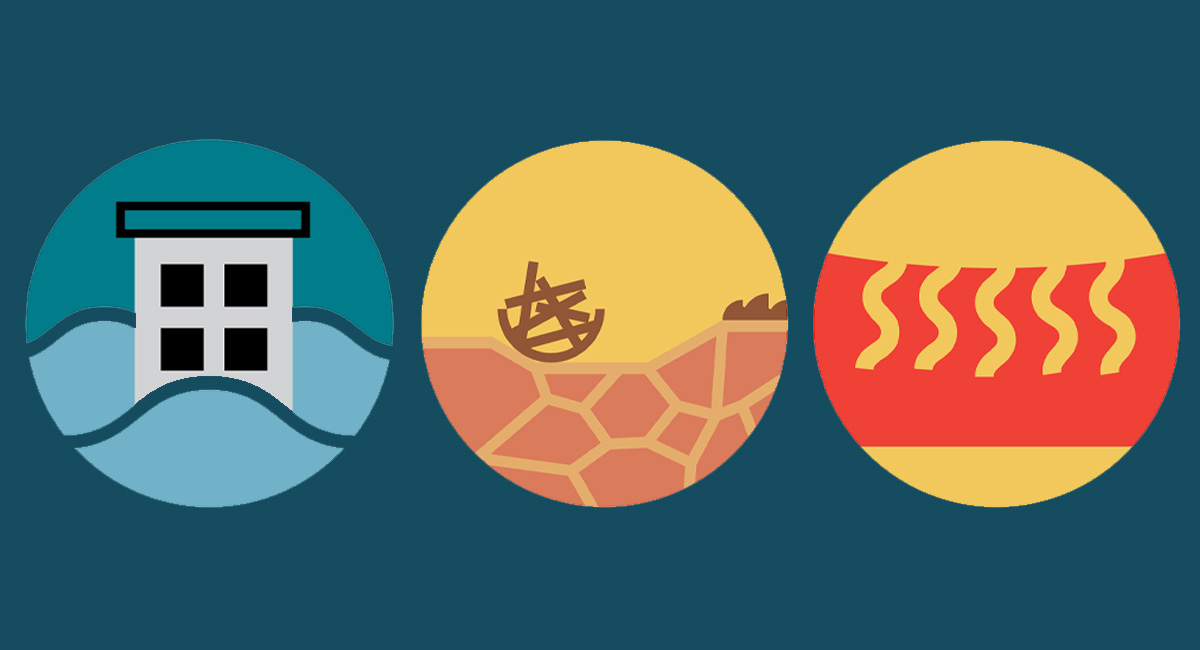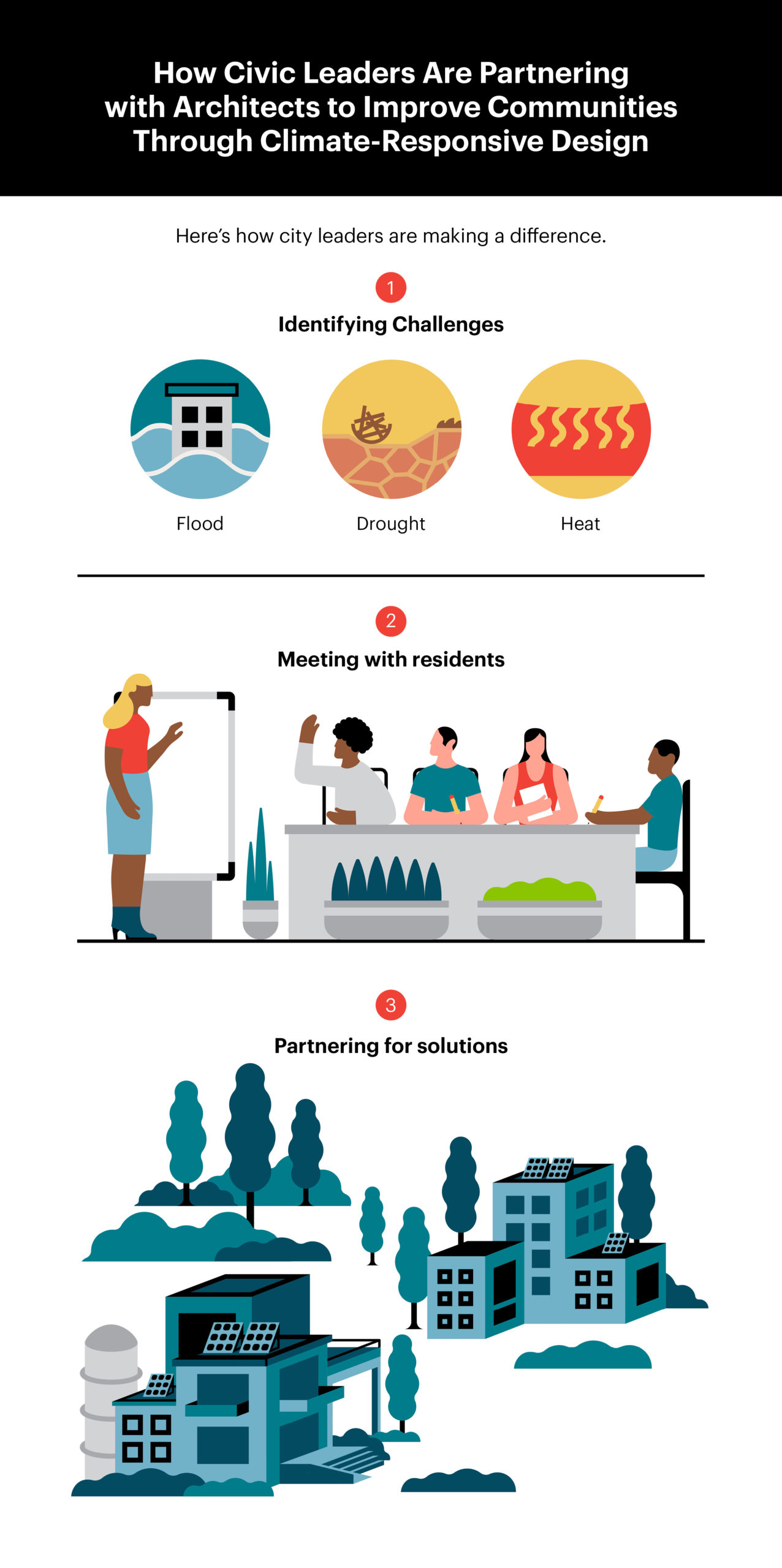
In 2021, Florida’s Miami-Dade County took an innovative approach to addressing how climate change impacts marginalized communities: It created the world’s first chief heat officer.
Across the United States, rising heat is disproportionately impacting communities of color living in neighborhoods that were redlined decades ago and denied parks and trees that provide shade. According to a 2021 study published in the journal Nature, the “average person of color lives in a census tract with higher summer daytime surface urban heat island (SUHI) intensity than non-Hispanic whites in all but 6 of the 175 largest urbanized areas in the continental United States.”
To change this, communities like Miami-Dade County are creating priority development areas—zones for long-term sustainable development that benefit local residents—as well as new municipal roles that use design to address climate change. For instance, Jane Gilbert, Miami-Dade County’s chief heat officer, is creating a plan to institute a range of heat-mitigating measures, everything from expanding tree-canopy cover to building climate resilience hubs—places where residents can cool off when temperatures soar.
“Passive cooling, passive temperature control, efficient HVAC systems—those are baseline,” Gilbert said about architects incorporating heat mitigation into their design. “We need to look at backup energy sources—solar power with battery backup.…We need to look at cool pavements—we may need to update the cool-roof ordinance and require bikeways, walkways, and parking lots to be more reflective and possibly more permeable.”
From heat to flooding to drought, natural disasters highlight how inequities in the built environment are intensifying the impact of climate change for marginalized and vulnerable communities. Here’s how civic leaders are making a difference—and boosting their cities’ economic prospects in the process.
Ensure all communities have equitable solutions to rising heat
Currently, most city neighborhoods have dark-colored, impervious surfaces atop buildings and on streets. Yet dark roofs elevate temperatures in the surrounding air by 52%, raising cooling costs and energy consumption, while blacktop intensifies runoff and flooding. All these factors disproportionately affect residents in neighborhoods with the fewest number of trees—historically, low-income communities.
“The way cities are designed today, low-income areas commonly get 10 to 14 degrees hotter than other, more affluent areas,” said Greg Kats, the founder and CEO of Smart Surfaces Coalition, a nonprofit working to transform urban spaces. “There are fewer trees, radiant heat is pouring off dark surfaces, and the air quality is bad. This means that kids aren’t outside and folks aren’t meeting on the streets or exercising, which results in higher crime and obesity levels.”
To improve social and environmental resilience in neighborhoods, architects are working with city planners to replace asphalt with smart surfaces to lower heat levels and bolster public health and safety. In Oakland, California, for example, architects helped create Tassafaronga Village, a 7.5-acre affordable housing community built on a former brownfield infill site that now features apartments, landscaped paths, a park, and more. Smart surfaces include reflective and porous pavements, green or reflective roofs, solar panels, and trees. These surfaces emit less heat, save money on energy, reduce emissions, and enhance quality of life. According to a Smart Surfaces Coalition report for the City of Baltimore conducted with Carnegie Mellon University professor Vivian Loftness, FAIA, smart-surface strategies could reduce peak summer temperatures downtown by more than four degrees while saving the city $13.5 billion over 30 years. That’s $21,000 per resident that could be used for community enhancing programs.
On a broader scale, AIA has also endorsed multiple pieces of legislation that would increase tree cover in residential areas across the United States, including the Green Neighborhoods Act and TREES Act.
Mitigate floods & pollution through development that benefits everyone
In 1948, Black veterans returning from World War II founded Carver Village in West Savannah, Georgia, near the Savannah River, as a community for affordable housing. Now home to over 500 houses, churches, and buildings, the neighborhood is on the National Register of Historic Places but is facing threats on three fronts: Flooding, industrial pollution, and gentrification. According to a report by the nonprofit Union of Concerned Scientists at the Massachusetts Institute of Technology, flooding in the Savannah area occurs about 10 times per year, an increase from five or fewer incidents 40 years ago, and could see a 10-fold increase to more than 100 events annually, plus a sea-level rise of an entire foot, by 2045. In addition to flooding, residents suffer negative health consequences from nearby industrial sites and may face rising costs due to gentrification, thanks in part to recent nearby developments like the Enmarket Arena and a 22-acre mixed-use project along the Canal District.
To ensure local residents have a voice when it comes to mitigating flooding, environmental injustice, and inequitable economic growth, District 1 city council representative Bernetta Lanier founded the Ivory Bay Community Development Corporation, which recently partnered with AIA’s Communities by Design program to host a Design Assistance Team. During the four-day process, architects, planners, and other experts worked hand in hand with civic leaders and the existing community to prioritize resident needs, developing recommendations that would ensure quality of life is prioritized and improved as development of the Canal District continues.
“AIA is a renowned professional organization dedicated to helping low-wealth communities transform by designing for better outcomes,” said Alderwoman Lanier. “Residents in Westside neighborhoods desperately need the services of AIA.”
AIA’s Design Assistance Team collaboration with the community resulted in infrastructure strategies to diminish flooding and improve quality of life.
Create space to conserve water & help communities flourish
As drought continues to be a challenge across the Southwest, rural communities are impacted most—and increasingly these are communities of color. According to the 2020 U.S. Census, the median rural county saw its population of color increase by 3.5 percentage points between 2010 and 2020. To help mitigate the impact of drought on rural residents—and offer needed resources—public buildings like libraries can serve as havens for learning and Internet access, as well as examples of water-saving design.
In Austin, Texas, Heather Holdridge, Associate AIA, the sustainability director at Lake Flato Architects, helped design the Central Library, a 2020 COTE Top 10 Awards winner. Located in an urban environment, the library can also serve as a model for rural design. Using techniques to engage communities like those found in the AIA Framework for Design Excellence, Holdridge and her team brought together all stakeholders, including local residents, to ensure the project would benefit the entire community. In addition to being a learning center to promote a more resilient community, the library is a model for water conservation in the drought-prone Texas hill country, with the building’s 373,000-gallon cistern capturing roof rainwater and HVAC condensate to supply restrooms and irrigate the landscape and vegetated roof.
“We started with an integrated design workshop with the design and construction team and owners, users, and community members,” Holdridge said. “It was about setting the vision, and out of it came the aspirations to be the best daylit library in North America and serve as a model for water conservation. Those goals—and being rigorous about tracking them—resulted in a LEED Platinum rating, rather than the other way around.”
Whether in cities or rural areas, civic leaders and architects are working together in new ways to mitigate the impact of climate change through design—helping to build community resilience for the long term.
Civic leaders: Partner with an architect
AIA’s Communities by Design program brings together architects and other professional disciplines to work alongside the residents, professionals, and institutions of host communities on key local issues.
Partner with an architect to discover ways to create resilient, sustainable communities that benefit everyone and every budget.
